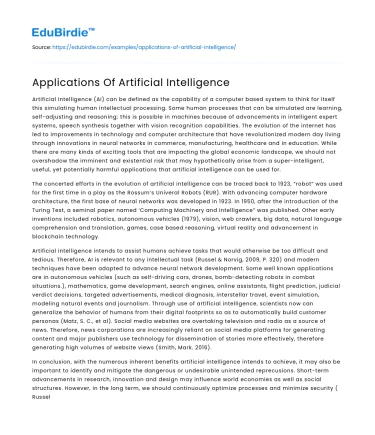Artificial Intelligence (AI) can be defined as the capability of a computer based system to think for itself this simulating human intellectual processing. Some human processes that can be simulated are learning, self-adjusting and reasoning; this is possible in machines because of advancements in intelligent expert systems, speech synthesis together with vision recognition capabilities. The evolution of the internet has led to improvements in technology and computer architecture that have revolutionized modern day living through innovations in neural networks in commerce, manufacturing, healthcare and in education. While there are many kinds of exciting tools that are impacting the global economic landscape, we should not overshadow the imminent and existential risk that may hypothetically arise from a super-intelligent, useful, yet potentially harmful applications that artificial intelligence can be used for.
The concerted efforts in the evolution of artificial intelligence can be traced back to 1923, “robot” was used for the first time in a play as the Rossum’s Univeral Robots (RUR). With advancing computer hardware architecture, the first base of neural networks was developed in 1923. In 1950, after the introduction of the Turing Test, a seminal paper named ‘Computing Machinery and Intelligence” was published. Other early inventions included robotics, autonomous vehicles (1979), vision, web crawlers, big data, natural language comprehension and translation, games, case based reasoning, virtual reality and advancement in blockchain technology.
Save your time!
We can take care of your essay
- Proper editing and formatting
- Free revision, title page, and bibliography
- Flexible prices and money-back guarantee
Artificial intelligence intends to assist humans achieve tasks that would otherwise be too difficult and tedious. Therefore, AI is relevant to any intellectual task (Russel & Norvig, 2009, P. 320) and modern techniques have been adopted to advance neural network development. Some well known applications are in autonomous vehicles (such as self-driving cars, drones, bomb-detecting robots in combat situations.), mathematics, game development, search engines, online assistants, flight prediction, judicial verdict decisions, targeted advertisements, medical diagnosis, interstellar travel, event simulation, modeling natural events and journalism. Through use of artificial intelligence, scientists now can generalize the behavior of humans from their digital footprints so as to automatically build customer personas (Matz, S. C., et al). Social media websites are overtaking television and radio as a source of news. Therefore, news corporations are increasingly reliant on social media platforms for generating content and major publishers use technology for dissemination of stories more effectively, therefore generating high volumes of website views (Smith, Mark. 2016).
In conclusion, with the numerous inherent benefits artificial intelligence intends to achieve, it may also be important to identify and mitigate the dangerous or undesirable unintended reprecusions. Short-term advancements in research, innovation and design may influence world economies as well as social structures. However, in the long term, we should continuously optimize processes and minimize security ( Russel, Stuart., Daniel Dewey, & Max Tegmark, 2015). Some of the unintended applications would include terrorists adopting digital warfare, unemployment as some jobs will be rendered redundant, devaluation of human life, social injustice and isolation, and robotics and ungoverned lethal autonomous weapons.






 Stuck on your essay?
Stuck on your essay?

